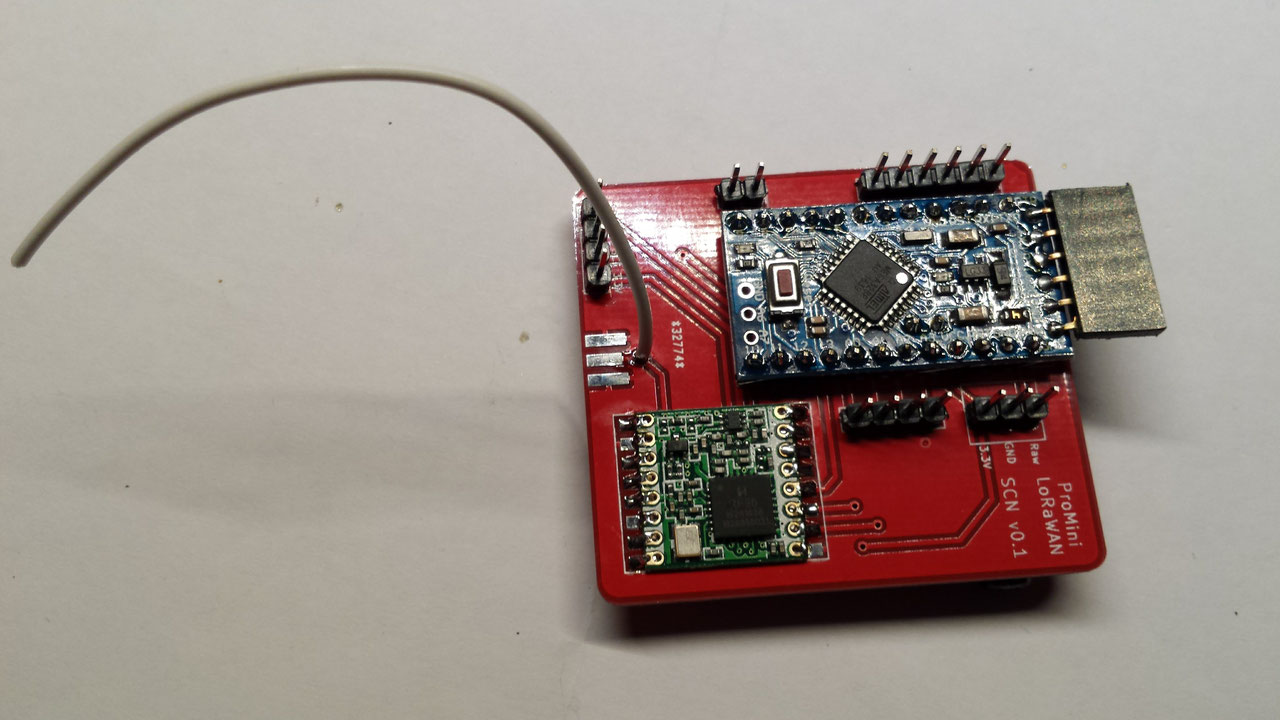Introduction
Bill of materials
Soldering the module
Setting up the peripherals
Starting up the Arduino Environment
Testing the sensors
Getting things started on ‘The Things Network’
Payload Function
Using Activation by Personalization (ABP)
Low Power the ProMini (Optional - experienced users only)
LMIC PIN mapping
Bits and values - Serialization of the data
Using the example code
Introduction
This is where the fun starts. Build your own small and easy to use node! After the building, we will program the node with some real examples, ending with temperature and airpressure measurement! Thanks to Doug Larue for his PCB design and sharing his manuals.
Bill of materials
Building a TTN node
Identifying the components
Our bill of materials (set available at TinyTronics)
RFM Module RFM95W (868 Mhz)
Pro Mini 3.3V 8Mhz (5V will NOT work!!)
FT232RL-3.3v-5v-TTL-USB-Serial-Port-Adapter (has to have a 3.3V option!)
USB cable for FTDI
1x Led 3mm red
1x resistor 1k (brown-black-red)
Header 6p female (Arduino programming)
Header 40p divided in: 2x 4p, 1x 6p, 1x 3p and 1x 2p
PCB ‘DougLarue’
Sensor BMP280 (Temperature and air pressure)
Battery holder 2x AA
2 AA batteries
optional: 2x female headers 2p (battery and led connection)
Low Power the Arduino?
There is an option to ‘low power’ the Arduino. BUT this requires some precise soldering! The setup will work without removing the components. So if you are a novice solderer, skip the first part! It requires a sharp knife to remove the power converter, and to cut the connections for the two on board leds. If you want to battery power your node for a longer time (weeks or more) this is the option for you. Current in sleep mode will be reduced to <100uA. Look at the instructions at the end of this manual
Soldering the module
Connect the 6p female header to the Arduino. To get it low profile bow it so it is straight with the PCB. You may solder the header at the top. | |
Position the RFM95 radio chip. The crystal should be in the right lower corner (as shown in the picture). Start with just a little solder in two opposite corners. You can fix the module with some Tesla tape | |
Align the solder pads and if the module is in place, solder the other pads. Do use as little as possible solder! Check the connections carefully! | |
You can cut the needed headers from the 40p header strip. Put two 12p headers into the ProMini socket. Also put the 2p header inside the ProMini area. By holding them with a piece of paper you can turn around the PCB. (You can also use the ProMini to keep the pins in place by using an elastic band.) | |
First solder the end pins, align the headers straight and solder all the other pins. | |
Turn around the PCB and solder the ProMini in place. Do not forget the two pin header! | |
Now solder the 6p, 2p, 3p and 4p header. | |
Cut a piece of wire, length 82.2 mm. This is a ¼ wave length antenna. You may add some short soldering end. | Wavelength =300/868 = 0.3456m Wavelength /4 = 0,0864 m correction 0.95*0.0864=0.0822m (to determine the precise length you can do some experiments, or use proper test equipment like a SWR meter) |
Solder the Antenna into the hole near the connector pins. It is also possible to solder an SMA edge connector and use a more professional antenna. |
Setting up the peripherals
Solder a header on the BMP280 barometric sensor | |
Prepare the LED, this requires a ‘helping hand’ for soldering. Cut the longest wire of the LED (‘+’), and the 1K resistor as shown | |
Now solder the resistor, you may use a spare female header to create a ‘connector’ or some female jumper wires | |
Put the LED ‘connector’ to pins 4 and 5 of the 6 pin jumper, as shown (Pin 4: GND, PIN 5 - D2), the resistor pin (‘+’) goes to pin 5 / D2. You may even solder the pins directly | |
You can solder the battery holder on the pins GND (black) and 3.3V (red), you may use a female header here as well | |
Put the Jumper on the FTDI board on 3.3V position! | |
Connect the USB cable to the FTDI board, the FTDI board to the Arduino as shown. |
Starting up the Arduino Environment
https://www.arduino.cc/en/Guide/HomePage
Install the Arduino IDE on your favourite platform (Mac, Linux or Windows). These examples work only with the latest Arduino IDE (tested on 1.6.9)!
https://www.arduino.cc/en/Guide/ArduinoProMini
Use the FTDI, ensure that the jumper is on the ‘3V’ side. Battery power turned off (check the switch)
Connect the FTDI and the Pro Mini so that the components are both facing up.
Start the Arduino IDE
Select the board: ‘Arduino Pro or Pro mini’
Select the Processor ‘ATmega328 (3.3V, 8Mhz)
Select the COM port given
Select the default ‘BLINK’ example, change the LED pin from 13 to 2, in the newest blink example you may change ‘LED_BUILTIN’ to 2.
Load the code with CTRL-U to the Pro Mini. After compilation and uploading the led on the board should blink at 1 Hz. Great: we have a working programming environment!
Testing the sensors
Add the BMP280 library: Sketch-> include library -> manage libraries:
Search for BMP280:
Install the library ‘I2C-Sensor-Lib’
Connect the BMP280 sensor:
Connect the BMP280 sensor with female-female jumper wires to the I2C connector: GND-> GND, SDA->SDA, SCL->SCL, VCC->+3.3V. The CSB en SDO are left open (only used in SPI connection). You can not connect straight forward, but you should twist the two wires in the middle. |
Load the the i2c_BMP280 example (File->Examples->I2C-Sensor-Lib->i2c_BMP280). By opening the Serial Monitor (115200 bps) you will see the height, pressure and temperature of the sensor. Put your finger on the sensor (the small metal unit) and see the temperature rise. The sensor’s height is relative and this library has a ‘fixed’ sea level pressure. (Beyond the scope of this workshop, we do not use the height, but if you want to experiment with it): To change this you have to change the i2c_bmp280.h file. In line 306, 102025 is the actual pressure:
meter = 44330.0*(1-pow(float(iPascal)/102025.0,1.0/5.255));
The Serial Monitor should display something like this:

Great! Our sensor is working! If it is not: check the I2C bus (SDA <-> SCL) and the two inner pins of the Pro Mini (A4 and A5) these two are the I2C bus! If you forgot to solder these, you can put a piece of wire through the holes and solder it at both sides.
Getting things started on ‘The Things Network’
Download the LMIC library from Github:
Choose ‘Clone or download’
Download ZIP
Mark the location
Go to Arduino IDE
Select ‘Sketch->Include Library->Add .ZIP Library’
Select the downloaded Arduino-lmic-master.zip file from your download location
Choose ‘Clone or Download’
Download ZIP
Mark the location
Go to Arduino IDE
Select ‘Sketch->Include Library->Add .ZIP Library’
Select the downloaded low-power-master.zip file from your download location
To help joining OTAA faster (seconds in stat of 7 minutes) you may alter the LMIC library. You can find LMIC.C file in <My Documents>\Arduino\Libraries\Arduino-lmic-master\src\lmic
Open the file in your favorite source code browser (or use WordPad)
Go to line 684 (or find ‘setDrJoin’ to find the line below)
Change setDrJoin(DRCHG_SET, DR_SF7); to: setDrJoin(DRCHG_SET, DR_SF9);
Save LMIC.C
The Things Network Dashboard
Your applications and devices can be managed by The Things Network Dashboard.
Create an Account
To use the dashboard, you need a The Things Network account. You can create an account here:
https://account.thethingsnetwork.org/users/login .
After registering and validating your email address, you will be able to log in to The Things Network Dashboard.
Create an Application
https://console.thethingsnetwork.org/applications
Choose ‘add application’
Give your Application a unique ID. You can use ONLY lowercase! You can add an unique number to get uniqueness over the ttn network (this is a global ID)
Your description can be any description you like.
First download the code for ttn_bmp280i.ino from https://github.com/galagaking/ttn_nodeworkshop
You can download the ZIP and unzip the file to get the examples:
Choose ‘Clone or download’
Download ZIP
Open the ZIP in explorer
Open the example ttn_bmp280.ino
Create the sketch folder for the application
Register the device
Now register your device. We will use OTAA in this example. This is ‘Over the Air Authentication’. You have to define an address for yourself. This is a kind of MAC address, but because there is no registration yet of these, define some RANDOM 8 byte value, using your postcode and some values in between.
There are three values you should copy into your Arduino Code. Dev EUI (the device identifier), App EUI (The application identifier) and the App key.
Dev EUI
With the <> sign you can select different ‘views’. We need the ‘LSB’ view, also called little Endian or Least Significant Byte First.
NOTE: For the App Key we need MSB, not LSB.
Both Dev EUI and App EUI will be used in LSB or little Endian format.
First copy the Dev EUI with the clip board sign on the right. Paste the string into your code at the static const u1_t DEVEUI. Remember to respect the semicolon at the end of the line.
APP EUI
Next copy APP EUI, select LSB for this one as well. Copy to APPEUI in your code.
APP KEY
The last key is a secret hash, so this one just shows when you click the ‘EYE’ icon. After that you can copy this to the clipboard. This one can be copied in MSB format.
Copy the 16 bytes APPKEY after static const u1_t APPKEY[16] = .
If things are not working, in most cases LSB and MSB are mixed up. So follow again above instructions and take care of LSB and MSB!!
- The BMP280 sensor should be connected!
- Upload your code to the Arduino.
- The LED will blink during the JOIN process. The Arduino gets his keys from TTN, thereby all information sent will be encrypted with these keys.
You can also follow this process by activating the ‘data’ view:
Payload Function
After a few seconds, the LED will stop blinking. You will see the information coming in into the dashboard. This is coded information, because some algorithm is used to put temperature and humidity in two bytes.
To get the right display format, we can create a decoder in our application. Select your application and open the ‘Payload Functions’:
Enter the function below, overwriting the standard function
function Decoder(bytes, port) {
var mbar = 970+((bytes[1] >> 2) & 0x3F);
var temperature = -2400+6.25*(((bytes[1] & 0x03) << 8) | bytes[0]);
return {
mbar: mbar,
celcius: temperature / 100.0
};
}
First test the function with two dummy bytes CE D0, And then Save the function.
Return to your data and look what happens:
This way you can put several values into a byte string. Sending in clear ASCII is possible but due to bandwidth limitations not preferable in production environments. To make this even more scalable take a look at https://github.com/thesolarnomad/lora-serialization .
DOWNLINK
To send bytes to our node we can use the ‘Downlink’ section: in the console, click on your device and scroll down in the Overview page . Enter one byte (two hex digits, 05 for example) and click Send.
The information will be send to the node after the next time the node contacts the gateway. With a sample rate of approx. 60 seconds, that is the maximum time this data will be received. The Led will blink this amount of times, with a maximum of 10 (0x0A).
Using Activation by Personalization (ABP)
ABP
Activation by Personalization (ABP) is a method where the security keys are stored in the device. Not as safe as the OTAA method, but for experiments it works OK. There is no join procedure, nodes will work right away.
Register the device.
Now edit the settings of the device and choose ABP (OTAA will be selected by default)
Select ‘save’. Now some values are system generated and we have to copy them to our code. We use the ttn_bmp280_abp.ino example here.
Copy the Device Address as a HEX value to DEVADDR in the example, so 26 01 1A 32 will be 0x26011A32.
Copy the Network Session Key as MSB to NWSKEY.
Copy the App Session Key as MSB to APPSKEY.
Compile and upload the code. Check in the dashboard the working.
You might want to uncheck the frame counter check
If the frame counter is checked, you must respect the sequence number, and probably copied packages are refused on the network. Though restarting you node, and thereby resetting the frame counter, will disable your node. So to get this working, you have to disable this check by unchecking this box. You can integrate the code of ttn_bmp280 in the abp example.
Low Power the ProMini (Optional - experienced users only)
These steps require precise soldering and cutting. Experienced users only, you may destroy your ProMini!
Remove the Regulator
The easiest way to remove the regulator and not damage the board is to use a very sharp scalpel to cut through the regulator leads at the point they join the regulator body.
Remove the LEDs
There are two LEDs on the Pro Mini board. The two LEDs are marked with a red square in the following picture. The power LED is marked with an arrow. If you are not sure where the power LED is on your board, then you can just power it and you will see the LED.
When you found the power LED, then try to locate at least one trace that leads to the LED. In the second picture below, I marked the traces on my board. A high-resolution picture with a lot of light helps to find the traces.
When you found a trace to the power LED, then you take a knife and break the trace, so that it will not conduct any more. You can see my result in the third picture below.
Removing the LEDs can be tricky, so it’s easier to remove the series resistors for the LEDs instead. This version of Pro Mini also has a resistor feedback network for the regulator across VCC, these consume power so should be removed. Just push the resistors aside with a soldering iron. The picture shows the Pro Mini with unwanted parts removed, locations of the removed components are circled in red.
More on this subject you may find at: https://andreasrohner.at/posts/Electronics/How-to-modify-an-Arduino-Pro-Mini-clone-for-low-power-consumption/

LMIC PIN mapping
LMIC Pin Mapping
If you are using other ‘LMIC’ or TTN examples, there is ONE part to take care of, the pin setting of the RFM95 module. Most times you have to adjust this to the pinout of the board:
// Pin mapping is hardware specific | |
const lmic_pinmap lmic_pins = { | |
.nss = 10, | |
.rxtx = LMIC_UNUSED_PIN, | |
.rst = LMIC_UNUSED_PIN, | |
.dio = {4, 5, 7}, //DIO0, DIO1 and DIO2 connected | |
}; |
And even more…
You can add professional Antenna’s on the PCB by using the appropriate connector.
Using the example code





